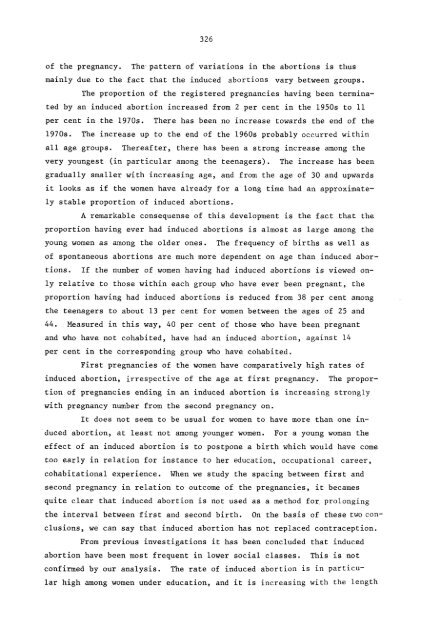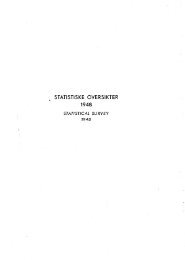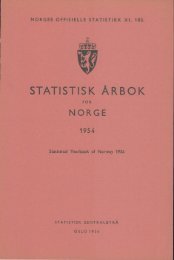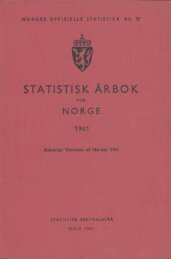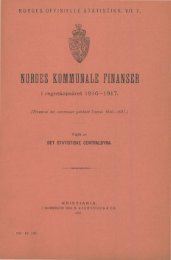- Page 2:
FRUKTBARHET BLANT NORSKE KVINNER RE
- Page 5 and 6:
FORORD Denne publikasjonen gir en b
- Page 8 and 9:
INNHOLD Side Figurregister 13 Tabel
- Page 10 and 11:
Side 7. Seksuell aktivitet 230 7.1.
- Page 12 and 13:
Page 5. Births 124 5.1. Introductio
- Page 14 and 15:
13 FIGURREGISTER 2.1. En forenklet
- Page 16 and 17:
15 Side 9.4. Viktigste utsagn som g
- Page 18 and 19:
17 Side 4.9. Gjennomsnittlig antall
- Page 20 and 21:
19 Side 8.1. Kvinner i ulike alders
- Page 22 and 23:
21 INDEX OF FIGURES 2.1. A simplifi
- Page 24 and 25:
23 7.6. Median age at first marriag
- Page 26 and 27:
25 Page 4.9. Average number of spon
- Page 28 and 29:
27 Page 8.5. Percentage of women ha
- Page 30 and 31:
2 9 at vi ikke fikk kontakt med int
- Page 32 and 33:
31 det ut som om kvinnene lenge har
- Page 34 and 35:
33 26 og 27 år hadde 3/4 av kvinne
- Page 36 and 37:
35 Avstanden mellom fødslene varie
- Page 38 and 39:
37 uformelle samlivsformer. Fordi s
- Page 40 and 41:
39 tenåringer, har de som var grav
- Page 42 and 43:
41 metodene. Andelen var om lag 60
- Page 44 and 45:
43 Tilsvarende har vi sett på prev
- Page 46 and 47:
45 bare sjelden nevnt. På grunn av
- Page 48 and 49:
47 koordinert og analysert en del a
- Page 50 and 51:
49 for kvinner med ulik prevensjons
- Page 52 and 53:
51 som ikke ble intervjuet i fOrste
- Page 54 and 55:
53 Tabell 2.2 (forts.). Utvalg, fra
- Page 56 and 57:
55 Avgjørelsen om i hvilken utstre
- Page 58 and 59:
57 4 uker fOr intervjuet. SpOrsmål
- Page 60 and 61:
59 2.6 Planer for utnytting av Fruk
- Page 62 and 63:
61 3. UTVIKLING I FOLKETALL OG FRUK
- Page 64 and 65:
63 Fr 1815 varierte de årlige veks
- Page 66 and 67:
Figur 3.2. Aldersspesifikke fruktba
- Page 68 and 69:
67 barn til at neste generasjon ikk
- Page 70 and 71:
69 Figur 3.3 (hentet fra Brunborg 1
- Page 72 and 73:
71 Tabell 3.3. Gjennomsnittsalder v
- Page 74 and 75:
73 og nær byene Stavanger, Bergen
- Page 76 and 77:
75 Figur 3.4. Samlet fruktbarhetsta
- Page 78 and 79:
77 medisinsk strengt nødvendig. St
- Page 80 and 81:
79 På midten av 1960-tallet ble en
- Page 82 and 83:
81 4. SVANGERSKAP OG ABORT 4.1. Inn
- Page 84 and 85:
avvik av betydning. Avvik av en vis
- Page 86 and 87:
85 aldersklasser. Det synes som om
- Page 88 and 89:
87 som betydelig lavere enn den "sa
- Page 90 and 91:
89 med at vi bruker en feilaktig al
- Page 92 and 93:
J40-4 91 Tabell 4.3.a. Utfall av sv
- Page 94 and 95:
93 Andelen av svangerskapene som en
- Page 96 and 97:
95 Tabell 4.4. Utfall av svangerska
- Page 98 and 99:
97 Tabell 4.4.d. Utfall av svangers
- Page 100 and 101:
99 G c0 -I, 0) CD CD t'S) C4 -a
- Page 102 and 103:
101 rammene av en oversiktspublikas
- Page 104 and 105:
103 En beregning av avhengigheten m
- Page 106 and 107:
105 I abortdiskusjonen har omfanget
- Page 108 and 109:
107 Av alle aborter som har oppgitt
- Page 110 and 111:
109 Antall spontane aborter stiger
- Page 112 and 113:
111 4.5.2. Framkalte aborter 4.5.2.
- Page 114 and 115:
113 Tabell 4.12. Andel med framkalt
- Page 116 and 117:
115 mens forskjellen går motsatt v
- Page 118 and 119:
117 Tabell 4.15. Andel blant kvinne
- Page 120 and 121:
119 Det andre grupperingssystem som
- Page 122 and 123:
121 4.5.2.3. Abortandelens variasjo
- Page 124 and 125:
123 når i svangerskapet kvinnen se
- Page 126 and 127:
125 andre kilder vet vi at det har
- Page 128 and 129:
127 kvinner som utvilsomt vil få b
- Page 130 and 131:
129 Enkelte vil kan hende savne en
- Page 132 and 133:
131 ikke regnet med å få barn. Pr
- Page 134 and 135:
133 5.2.2. Kvinnens alder ved fOrst
- Page 136 and 137:
Figur 5.5. Andel av fOrste levendef
- Page 138 and 139:
137 Proportion who have had their f
- Page 140 and 141:
139 skyldes dels manglende data og
- Page 142 and 143:
141 for fast parforhold. Sammenhold
- Page 144 and 145:
143 fOdt, vil med andre ord også h
- Page 146 and 147:
145 barnet helt i innledningen av e
- Page 148 and 149:
147 Slike bakgrunnsvariable vil på
- Page 150 and 151:
149 Tabell 5.6. Mediana1der 1) ved
- Page 152 and 153:
151 I kartleggingen av kvinnenes op
- Page 154 and 155:
153 5.2.7. FOrste levendefødsel og
- Page 156 and 157:
155 Figur 5.11. Andel som har hatt
- Page 158 and 159:
157 Fra 1950 til 1970 steg tallet p
- Page 160 and 161:
159 utdanningsvarighet (mer enn 12
- Page 162 and 163:
161 5.3. Videre forløp av den fruk
- Page 164 and 165:
163 Figur 5.14. Andel som har hatt
- Page 166 and 167:
165 5.3.2. Avstand mellom første o
- Page 168 and 169:
167 Tabell 5.9. Kvinner i grupper f
- Page 170 and 171:
169 20-årsalder, ikke gift ved for
- Page 172 and 173:
171 Figur 5.16. Tid mellom fOrste o
- Page 174 and 175:
173 Figur 5.17. Tid mellom annen og
- Page 176 and 177:
175 Tabell 5.12. Kvinner i grupper
- Page 178 and 179:
177 Tabell 5.13. Kvinner i grupper
- Page 180 and 181:
179 Figur 5.18. Tid mellom første
- Page 182 and 183:
181 Tabell 5.14. Kvinner i ulike al
- Page 184 and 185:
183 20-åra en viss nedgang. Den ku
- Page 186 and 187:
185 Tabell 5.16. Kvinner i grupper
- Page 188 and 189:
187 Vi har vist hvordan antallet le
- Page 190 and 191:
189 i fødselsintervallene er alt i
- Page 192 and 193:
191 som ikke har hatt en eneste fOd
- Page 194 and 195:
193 Tabell 5.18. Kvinner i grupper
- Page 196 and 197:
195 fOrste barn ved 30-årsalder el
- Page 198 and 199:
197 at så sant kvinner har mulighe
- Page 200 and 201:
199 å få de to første barna noe
- Page 202 and 203:
201 er klare forskjeller mellom de
- Page 204 and 205:
203 6.2. Samlivsstatus ved intervju
- Page 206 and 207:
205 husholdningen, at de ikke er sk
- Page 208 and 209:
207 Vi ser at forskjellen mellom ku
- Page 210 and 211:
Prosent Percentage 40 . 30- Figur 6
- Page 212 and 213:
211 Når vi går bakover i tid, vil
- Page 214 and 215:
213 Kvinner fOdt 1933 - 1937 har al
- Page 216 and 217:
215 mellom 18 og 44 år, samliv ute
- Page 218 and 219:
217 samliv under ett, viser det seg
- Page 220 and 221:
Type forste samliv Type of first co
- Page 222 and 223:
221 6.4.2. Oppløste ekteskap Vi sk
- Page 224 and 225:
223 En annen egenskap som henger no
- Page 226 and 227:
Tabell 6.8. Prosentandel med opplø
- Page 228 and 229:
227 observasjoner i alt og på hver
- Page 230 and 231:
229 valgte samliv uten vigsel også
- Page 232 and 233:
231 starter for å få vite hvor la
- Page 234 and 235:
233 skulle gis i hele år. Særlig
- Page 236 and 237:
235 Figur 7.3. Medianalder" ved 1.
- Page 238 and 239:
237 Vi har i tabell 7.1 vist hvorda
- Page 240 and 241:
239 Figur 7.5. Andelen som lever el
- Page 242 and 243:
241 Vi legger stor vekt på å se h
- Page 244 and 245:
243 Figur 7.7. Andel som har hatt s
- Page 246 and 247:
245 Det er også av interesse å se
- Page 248 and 249:
247 8. PREVENSJON 8.1. Innledning U
- Page 250 and 251:
249 tilknytning til noen av de amer
- Page 252 and 253:
251 Av de metodene som krever en be
- Page 254 and 255:
253 Monsteret skyldes sannsynligvis
- Page 256 and 257:
. . Women 1) sn dsfferent age group
- Page 258 and 259:
257 Spiralbruken er hOyest (44 pros
- Page 260 and 261:
259 Percentage of women having used
- Page 262 and 263:
261 I den siste gruppen både når
- Page 264 and 265:
263 mellom de ulike metoder er mOns
- Page 266 and 267:
co Q 265 cf") Q 11.-: —et 1 Y, ZI
- Page 268 and 269:
267 Tabell 8.6. Andel av kvinnene m
- Page 270 and 271:
269 Når en kvinne eller et par vel
- Page 272 and 273:
271 de to bruksratene godt kan skyl
- Page 274 and 275:
273 gjelder å godkjenne nye medika
- Page 276 and 277: 275 Tabell 8.9. Andel av kvinnene s
- Page 278 and 279: 277 Figur 8.4. Bruksrater for preve
- Page 280 and 281: Tabell 8.10. Andel av kvinnene som
- Page 282 and 283: 281 For å illustrere hva en kan f
- Page 284 and 285: 283 co g-, I • o) I II i . .i-i /
- Page 286 and 287: 285 metode til en annen, ble det re
- Page 288 and 289: 287 Når det gjelder hvor lenge den
- Page 290 and 291: 289 Tabell 8.12. Andel av kvinnene
- Page 292 and 293: 291 ha påvirket avgjorelsen. Blant
- Page 294 and 295: 293 9. HOLDNINGER TIL FRUKTBARHETEN
- Page 296 and 297: 295 de allerede har fOdt. I det and
- Page 298 and 299: 297 behandling enn hva som til nå
- Page 300 and 301: 299 9.2. Ideelt barnetall Samtlige
- Page 302 and 303: 301 Resultatene viser et gjennomsni
- Page 304 and 305: 303 Figur 9.2. Ideelt antall barn f
- Page 306 and 307: 305 Samtlige kvinner som ble interv
- Page 308 and 309: 307 Figur 9.4. Viktigste utsagn som
- Page 310 and 311: 309 Tabell 9.3. Kvinner med og uten
- Page 312 and 313: . ap • ▪ • ) 00 0 •H .1, 0
- Page 314 and 315: 313 kvinner 25-34 år er det over h
- Page 316 and 317: 315 FruktbarhetsundersOkelsen spurt
- Page 318 and 319: 317 Som vi ser av tabell 9.6, har-v
- Page 320 and 321: 319 Konsentrasjonen om 2 og 3 barn
- Page 322 and 323: 321 eventuelt foretrekkes. Det kan
- Page 324 and 325: 323 SUMMARY IN ENGLISH The purpose
- Page 328 and 329: 327 of education. With this excepti
- Page 330 and 331: 329 her reproductive period. Among
- Page 332 and 333: 331 The timing and spacing of birth
- Page 334 and 335: 333 There are a number of notable d
- Page 336 and 337: 335 was right. Women that never had
- Page 338 and 339: 337 In contrast to the IUD and the
- Page 340 and 341: 339 As a further illustration, we h
- Page 342 and 343: 341 work outside the home, problems
- Page 344 and 345: 343 Engelstad, Fredrik (1980): Yrke
- Page 346 and 347: 345 Simons, John (1978): Illusions
- Page 348 and 349: 347 Nr. 19 Det norske kredittmarked
- Page 350: 349 Nr. 49 Fruktbarhet blant norske


